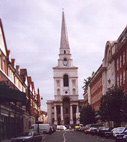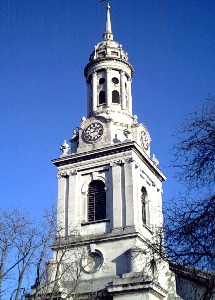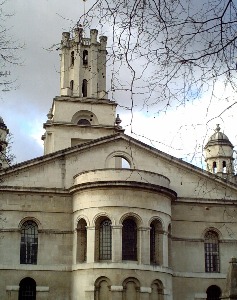
HAWKSMOOR CHURCHES
 |
|
| london-footprints.co.uk |
Whether you like them or not (and I'm not a great fan) Hawksmoor's churches certainly make an impact on London, if only by their sheer size. They range from large to enormous and I sometimes wonder whether there was an error of scale on the drawings and they got built much bigger than intended!
All seven were constructed under the Act of 1711 which proposed to build '50 new churches of stone and other proper materials with towers or steeples'. This scheme was put forward by the Tories, partly to celebrate the fall of the Whigs after 22 years but also because law and order in the suburbs was thought to be suffering for want of churches.
However only about 14 churches were produced of which the latter ones were re-builds of existing buildings. Hawksmoor was one of the surveyors of the commissioners and his designs, along with churches by Archer and Gibbs, were new builds. Perhaps the expense of these reduced the numbers - St Anne's for instance cost £32,232 8s 7d plus £400 for the site.
 |
A catalyst to
the Act was the loss of ST ALFEGE'S CHURCH in Greenwich,
when the roof collapsed during a storm in 1710. The
parishioners petitioned for funds from the coal tax as
they were unable to finance a new church themselves. It
was built against a surviving tower to reduce costs. This
was later encased and the steeple, designed by John
James, added in 1730. The designs for a tower that
Hawksmoor planned were later used at St Anne's Limehouse.
It was virtually gutted by war damage in May 1941 but
restored by Sir Albert Richardson in 1953. General James
Wolfe, killed at Quebec in 1759 and composer Thomas
Tallis who died in 1585 are buried under the church. |
|
|
|
|
Another monster is CHRIST CHURCH
SPITALFIELDS, one which very nearly became extinct!
Little money had been spent on the church since its
completion in 1714. The rotten state of the roof and
ceiling meant that the church had to be closed in 1957 as
a dangerous structure. The diocese thought to demolish it
and sell its site but this led to the formation of the
Hawksmoor committee who succeeded in stopping this. Money
for repairs was raised by the sale of St John's Smith
Square (gutted in the Blitz) for use as a concert hall. A
Friends of Christ Church was set up to restore the
building aided in 2000 by a Heritage Lottery Grant of
£2.44m. The restored interior should be open to view on
Tuesdays 11-3. The Museum of London recorded and cleared burials in the crypt which is now used as a rehabilitation centre for alcoholics. An old notice remains on the north side stating where keys to the church could be obtained in case of fire. It is a used as a venue for the Spitalfields Festival and there is a Friends website. Featured on Spitalfields walk |
|
 |
|
|
|
|
|
ST LUKE'S OLD STREET was designed with
John James in 1727-33 and features an obelisk spire. It
was built to relieve St Giles Cripplegate with which it
later reunited. In 1959 the roof was found to be unsafe
and was removed leaving the church at the mercy of the
elements. However it has now been Grade I listed and
transformed into a rehearsal, performance and education
building for the London Symphony Orchestra with a cafe in
the reconstructed crypt. There is a programme of events
including concerts and workshops open to the public. [website] Featured on Finsbury walk |
© london-footprints.co.uk 2010
Resources
London's Churches by Elizabeth & Wayland Young
There is an unusual novel 'Hawksmoor' by Peter Ackroyd which
combines the story of the building of the churches with a modern
murder investigation.